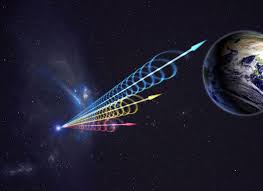Have you ever looked up at the night sky and wondered what stories those twinkling lights are trying to tell? For centuries, humans have relied solely on the narrow window of visible light to observe the cosmos. But what if I told you that the universe is ablaze with a symphony of light far beyond what our eyes can perceive? This “invisible light” holds the key to unlocking some of the universe’s deepest secrets, and it’s all thanks to the electromagnetic spectrum.
Think of the electromagnetic spectrum as a vast ruler measuring different types of light, organized by their wavelength and frequency. At one end, you have long, low-energy radio waves, the kind that carry your favorite music. At the other end, you find short, high-energy gamma rays, the most energetic form of light. In between lie microwaves, infrared radiation, the familiar visible light we see, ultraviolet radiation, and X-rays.
The amazing thing is that different celestial objects and processes emit different parts of the electromagnetic spectrum. By studying this cosmic “rainbow,” astronomers can piece together a much more complete and vibrant picture of the universe than visible light alone allows. Let’s take a tour through the spectrum and see what each region reveals:
Radio Waves: Whispers from the Cosmos

What they reveal: Cold gas clouds, the afterglow of the Big Bang, pulsars, and the structure of galaxies.
Why they’re important: Radio waves can travel through dust clouds that block visible light, allowing us to see into the heart of galaxies and star-forming regions. Radio telescopes, often massive dishes, collect these faint signals.
ISRO’s Contribution: India has a strong presence in radio astronomy. While primarily ground-based, facilities like the Giant Metrewave Radio Telescope (GMRT) in Pune, though not directly run by ISRO, are world-class instruments that contribute significantly to studying the universe in radio wavelengths. Furthermore, ISRO’s participation in the Square Kilometre Array Observatory (SKAO), the world’s largest radio telescope project, signals a strong future contribution to this field.
Microwaves: The Baby Picture of the Universe
What they reveal: Primarily the Cosmic Microwave Background (CMB), the afterglow of the Big Bang.
Why they’re important: Studying the subtle variations in the CMB provides crucial information about the early universe, its composition, and its evolution.
Infrared Radiation: The Heat Signature of the Universe
What they reveal: The heat emitted by stars, planets, and dust clouds. Newly formed stars still shrouded in dust are bright in infrared.
Why they’re important: Infrared telescopes can peer through dust that obscures visible light, revealing hidden stellar nurseries and distant galaxies whose light has been stretched by the expansion of the universe.
ISRO’s Contribution: ISRO has utilized infrared instruments in its missions. For example, the Spectrometer Infrared (SIR-2) onboard India’s pioneering lunar mission, Chandrayaan-1, studied the lunar surface in infrared to map mineral composition. Future missions, like the planned Venus Orbiter Mission (Shukrayaan-1), may also incorporate infrared instruments to study the Venusian atmosphere and surface.
Visible Light: The Familiar Glow
What it reveals: The light emitted by stars due to their nuclear fusion. This is the part of the spectrum our eyes are sensitive to, allowing us to see planets, stars, and galaxies directly.
Why it’s important: While limited, visible light observations have formed the foundation of astronomy for centuries, providing information about the temperature, composition, and motion of celestial objects.
Ultraviolet Radiation: Energetic Light from Hot Objects
What it reveals: Extremely hot and energetic objects like young, massive stars and active galactic nuclei.
Why it’re important: Earth’s atmosphere blocks most ultraviolet radiation, so UV telescopes in space are crucial for studying these high-energy phenomena.
ISRO’s Contribution: A cornerstone of ISRO’s astronomical endeavors is AstroSat, India’s first dedicated multi-wavelength space observatory. Its Ultra Violet Imaging Telescope (UVIT) is a key instrument, capable of observing in both near and far ultraviolet bands. UVIT has made significant discoveries, including detecting extreme-UV light from one of the earliest galaxies, AUDFs01, a groundbreaking observation.
X-rays: Violent Events in the Cosmos
What they reveal: Extremely hot gas in environments like supernova remnants, around black holes, and in galaxy clusters.
Why they’re important: X-ray astronomy allows us to study the most energetic events in the universe, such as material falling onto black holes and the shockwaves from exploding stars.
ISRO’s Contribution: AstroSat carries multiple X-ray payloads, including the Soft X-ray Telescope (SXT), Large Area X-ray Proportional Counter (LAXPC), and Cadmium Zinc Telluride Imager (CZTI), enabling simultaneous observations across a broad X-ray energy range. More recently, ISRO launched XPoSat (X-ray Polarimeter Satellite) in January 2024, India’s first dedicated mission to study the polarization of cosmic X-rays. XPoSat’s instruments (POLIX and XSPECT) are providing crucial insights into the magnetic fields and emission mechanisms of pulsars, black hole binaries, and other extreme X-ray sources, complementing international missions.
Gamma Rays: The Universe’s Most Energetic Explosions
What they reveal: The most violent events in the universe, such as supernova explosions, neutron star mergers, and active galactic nuclei. Gamma-ray bursts are the most powerful explosions known.
Why they’re important: Studying gamma rays helps us understand the physics of extreme environments and the most energetic processes in the cosmos.
ISRO’s Contribution: While not a dedicated gamma-ray observatory on its own, AstroSat’s CZTI (Cadmium Zinc Telluride Imager) also has capabilities in the hard X-ray and low-energy gamma-ray range, contributing to the study of these high-energy phenomena.
Seeing the Universe in Multiple Wavelengths: The ISRO Advantage
The true power of modern astrophysics lies in observing the same celestial object across the entire electromagnetic spectrum. ISRO’s AstroSat, with its unique ability to perform simultaneous multi-wavelength observations (UV, optical, and X-ray), exemplifies this approach. By combining data from these different “eyes,” astronomers can build a comprehensive understanding of an object’s nature, its physical processes, and its place in the universe.
So, the next time you gaze at the night sky, remember that the visible light you see is just one small part of a much grander cosmic picture. Institutions like ISRO, armed with advanced telescopes and a commitment to cutting-edge research, are constantly revealing the hidden beauty and intricate workings of our amazing universe, one wavelength at a time, solidifying India’s position on the global map of space astronomy.

